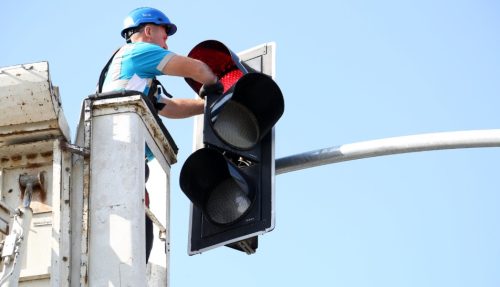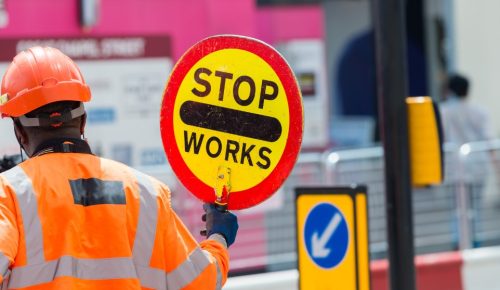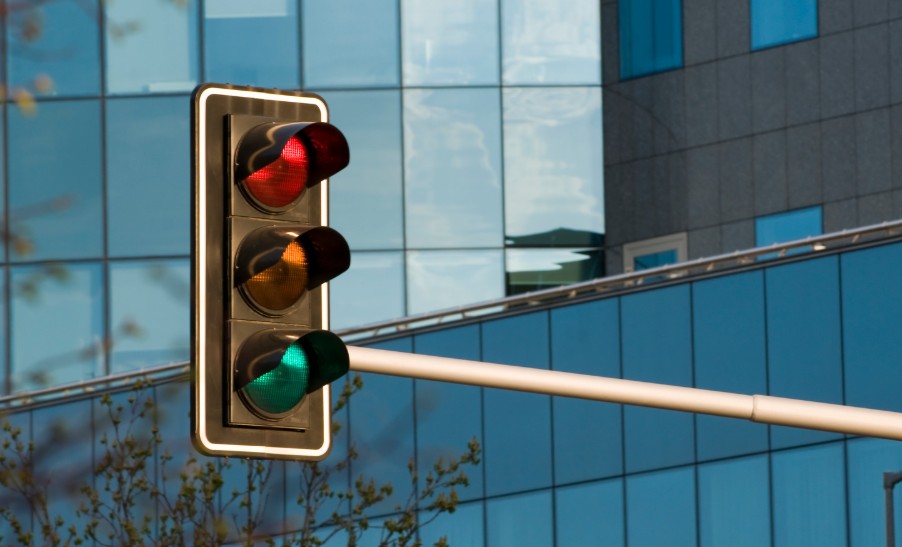Table of Contents
Traffic lights play a crucial role in maintaining road safety and smooth traffic flow. When they malfunction, they can cause confusion, delays, and even accidents.
Reporting faulty traffic lights quickly ensures they are repaired promptly, reducing risks for drivers, pedestrians, and cyclists. In the UK, different authorities handle traffic signals depending on their location.
Whether it’s a local road, motorway, or temporary roadwork signal, knowing how to report traffic lights not working is essential.
This guide will walk you through the process of reporting broken traffic lights, understanding who is responsible for repairs, and the possible legal consequences of ignoring malfunctioning signals.
What are the Common Causes of Traffic Light Failures?

Traffic light failures can occur due to various reasons. Some of the most common causes include:
Electrical Issues
- Power outages or electrical faults can cause traffic lights to stop working completely.
- Damaged wiring or faulty control boxes may lead to flickering or incorrect signals.
Physical Damage
- Road accidents, vandalism, and construction work can damage traffic signals.
- Severe weather conditions, such as storms or heavy winds, may also affect their functionality.
Sensor Malfunctions
- Some traffic lights use sensors to detect vehicles and adjust timings accordingly.
- A faulty sensor can cause delays or keep lights stuck on red or green.
Software or Programming Errors
- Outdated control systems may cause traffic lights to behave unpredictably.
- Incorrect programming can lead to inefficient traffic management.
Temporary Disruptions
- Roadworks often use temporary traffic signals, which can malfunction.
- Scheduled maintenance or upgrades may cause short-term failures.
Identifying the cause of a malfunction can help authorities determine how quickly the issue can be resolved.
What Should You Do If You Notice Faulty Traffic Lights?
If you come across a faulty traffic light, the first step is to assess the situation carefully. Determine whether the light is completely out, flashing, stuck on one colour, or behaving erratically.
If the lights pose a danger to road users, proceed with extra caution. For drivers, the Highway Code advises treating non-working traffic lights as an uncontrolled junction.
This means you should slow down, give way to traffic from the right, and proceed only when safe. If the lights are flashing amber, you must be prepared to stop if necessary. Pedestrians should remain cautious when crossing roads at malfunctioning signals.
Once you have ensured your safety, report the problem as soon as possible. Depending on the location, the responsible authority will either be your local council, Transport for London (TfL), or Highways England.
If the failure poses an immediate risk of accidents, you may need to contact the police to help direct traffic while repairs are arranged.
Who Is Responsible for Maintaining Traffic Lights in the UK?

Different authorities manage traffic lights in the UK, depending on their location and type.
Local Councils
Responsible for traffic lights on local roads, pedestrian crossings, and urban areas, with a reporting system for faulty signals.
Highways England (National Highways)
Manages traffic signals on motorways and major A roads, with issues reported through their online portal or contact centre.
Transport for London (TfL)
Oversees traffic lights within Greater London, allowing faults to be reported via their website or phone line.
Private Developers and Contractors
Maintain traffic signals in business parks and private roads, with verification from the local council on ownership.
If you are unsure who is responsible for a specific traffic light, you can use the Gov.uk website to find the correct authority.
Reporting to the right organisation ensures the issue is addressed as quickly as possible.
How to Report Traffic Lights Not Working?
Reporting a faulty traffic light depends on your location and the type of road it’s on. If you spot a malfunctioning traffic light, here’s how to report it efficiently:
Find Your Local Council
- Visit uk and enter the location to find the relevant local authority.
- Enter your postcode (e.g., SW1A 2AA) on your council’s website to find the correct authority.
- Look for the traffic light section to report a problem.
Provide Specific Information
To help authorities locate the faulty light, provide details like:
- Road names
- Nearby junctions
- Notable buildings
- Exact issues with the traffic light
Contact Methods
- Call 01454 868000 (24/7 service) or email trafficsignals@southglos.gov.uk for reporting.
- For faults with temporary traffic lights, phone 0800 23 23 23 (8 am–5 pm, Mon–Fri).
Emergency Issues
- For out-of-hours emergencies, contact Central Emergency Services at 0131 200 2000. This phone line is available 24/7 and connects to the Edinburgh region.
By following these steps, you can ensure a quick response to traffic light issues in your area.
What Information Do You Need to Provide When Reporting a Traffic Light Issue?

When reporting a faulty traffic light, providing the correct details ensures a faster resolution.
Essential Information to Include
- Exact location: Provide the street name, junction, or nearest landmark to pinpoint the exact spot of the faulty light.
- Type of issue: Specify if the traffic light is completely off, flashing, or stuck on red/green to help identify the problem.
- Time of failure: Mention when the issue first occurred and whether it’s ongoing, intermittent, or a recent fault.
- Impact on traffic: Describe if the malfunction is causing traffic congestion, delays, or accidents at the location.
- Your contact details (optional): Include your contact information if you’re open to being contacted for further details or updates.
Being clear and precise in your report helps engineers diagnose and fix the problem efficiently.
How Long Does It Take for Traffic Light Issues to Be Fixed?
The time it takes to fix a faulty traffic light depends on the issue’s severity and the responsible authority.
Urgent problems, such as complete signal failures or safety risks, are typically addressed within 24 to 48 hours. Minor issues like timing errors or sensor malfunctions may take longer, sometimes several days or weeks.
Emergency repairs are prioritized to prevent accidents, especially at busy intersections, and temporary solutions like manual signals may be used.
If a traffic light is damaged by an accident or vandalism, repairs can take longer due to the need for replacement parts. Roadworks and planned maintenance may also impact response times.
If the issue isn’t fixed within a reasonable period, residents can follow up with their local council or transport authority for updates.
Can You Report Temporary Traffic Light Problems During Roadworks?

Yes, temporary traffic light problems during roadworks can and should be reported. These issues often arise from malfunctioning lights, such as staying stuck on red or not responding to traffic flow.
Typically, construction companies or contractors manage these temporary lights, but unresolved problems can be escalated to the local council or Highways Agency.
Look for signage with contact details for the contractor; if unavailable, report the issue through the local council.
In cases of major disruptions or safety concerns, traffic officers may be deployed to manage traffic manually.
Keeping temporary lights functional is essential for preventing delays and ensuring the safety of drivers and pedestrians.
What Are the Legal Consequences of Ignoring Faulty Traffic Lights?
Ignoring faulty traffic lights can lead to serious legal and safety repercussions. According to the Highway Code, drivers should treat malfunctioning traffic lights as an uncontrolled junction.
This means they must:
- Give way to traffic coming from the right.
- Proceed with caution and be prepared to stop.
Failing to follow these rules may result in penalties such as:
- A Fixed Penalty Notice (FPN), including a fine of up to £100 and 3 penalty points.
- If an accident occurs, higher fines, prosecution, or driving disqualification may follow.
Running a red light, even if the signal is broken, is still a violation. Pedestrians and cyclists must also exercise caution around malfunctioning signals, as accidents could lead to disputes in insurance claims or complex legal issues.
To avoid legal complications, report faulty traffic lights promptly and adhere to safe driving practices.
Are There Alternative Traffic Management Solutions for Recurrent Signal Failures?

When traffic lights frequently fail in a particular area, alternative traffic management solutions may be considered to improve safety and efficiency.
These solutions can help maintain smooth traffic flow and reduce reliance on electronic signals.
Roundabouts
- Installing roundabouts at key junctions can eliminate the need for traffic lights.
- They help maintain continuous movement and reduce congestion, especially in areas prone to frequent signal failures.
Manual Traffic Control
- During major failures or emergencies, traffic officers can be deployed to direct vehicles manually.
- This solution is common during peak hours or in high-risk areas.
Smart Traffic Light Systems
- Upgrading to AI-powered or sensor-based traffic lights can improve reliability.
- These systems can automatically adjust timing based on real-time traffic conditions.
Improved Road Signage
- Clear road markings and additional signs can help drivers navigate intersections safely when signals are not working.
- Temporary stop signs can be installed at malfunctioning junctions.
Regular Maintenance and Inspections
- Increased routine inspections can help identify and fix issues before they lead to major failures.
- Councils may also invest in backup power systems to keep traffic lights operational during electrical failures.
These solutions help reduce the impact of signal failures, ensuring safer and more efficient road management.
Conclusion
Functional traffic lights are crucial for maintaining road safety and preventing accidents. When they fail, reporting them to the correct authority ensures a quick resolution.
Local councils, Highways England, and Transport for London each have specific responsibilities, and using their online or phone reporting services is the best way to get issues resolved.
Ignoring a faulty traffic light can lead to serious consequences, including fines, insurance complications, and road hazards.
By acting quickly and providing detailed information, road users play an important role in maintaining safe and efficient traffic systems across the UK.
If you notice a problem with a traffic light, report it immediately to help keep the roads safe for everyone.
FAQs About How to Report Traffic Lights Not Working
What should I do if a traffic light is flashing amber?
If a traffic light is flashing amber, drivers should slow down and give way to pedestrians or other vehicles before proceeding. Pedestrians should cross only when it is safe.
Can pedestrians report faulty pedestrian crossings in the UK?
Yes, pedestrians can report broken pedestrian signals to the local council via the Gov.uk website or local authority contact numbers.
Are there mobile apps to report broken traffic lights in the UK?
Some councils provide mobile apps for reporting road issues, and Transport for London offers an online reporting tool.
Who pays for traffic light repairs in the UK?
Traffic light repairs are funded by local councils, Transport for London, or Highways England, depending on the location.
What happens if a traffic light is out during peak hours?
If a traffic light fails during peak hours, authorities may send traffic officers to manage the situation until repairs are completed.
Can faulty traffic lights cause insurance issues in case of an accident?
Yes, accidents caused by malfunctioning traffic lights may complicate insurance claims, requiring additional evidence to determine liability.
How often are UK traffic lights inspected for maintenance?
Traffic lights are routinely inspected by local councils and national highway authorities, typically on a scheduled maintenance cycle.




